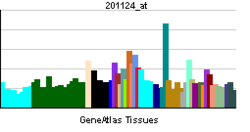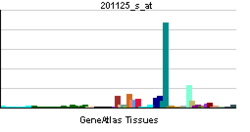Integrin, beta 5
| View/Edit Human | View/Edit Mouse |
Integrin beta-5 is a protein that in humans is encoded by the ITGB5 gene.[3][4]
Interactions
Integrin, beta 5 has been shown to interact with PTK2,[5] Annexin A5[6] and PAK4.[7]
Clinical significance
Research
Elevated levels of ITGB5 have been found in patients suffering from autosomal dominant osteopetrosis type II, a rare disease of bones.[8]
References
- ↑ "Human PubMed Reference:".
- ↑ "Mouse PubMed Reference:".
- ↑ McLean JW, Vestal DJ, Cheresh DA, Bodary SC (Nov 1990). "cDNA sequence of the human integrin beta 5 subunit". J Biol Chem. 265 (28): 17126–31. PMID 2211615.
- ↑ "Entrez Gene: ITGB5 integrin, beta 5".
- ↑ Eliceiri, Brian P; Puente Xose S; Hood John D; Stupack Dwayne G; Schlaepfer David D; Huang Xiaozhu Z; Sheppard Dean; Cheresh David A (Apr 2002). "Src-mediated coupling of focal adhesion kinase to integrin alpha(v)beta5 in vascular endothelial growth factor signaling". J. Cell Biol. United States. 157 (1): 149–60. doi:10.1083/jcb.200109079. ISSN 0021-9525. PMC 2173263
 . PMID 11927607.
. PMID 11927607. - ↑ Cardó-Vila, Marina; Arap Wadih; Pasqualini Renata (May 2003). "Alpha v beta 5 integrin-dependent programmed cell death triggered by a peptide mimic of annexin V". Mol. Cell. United States. 11 (5): 1151–62. doi:10.1016/S1097-2765(03)00138-2. ISSN 1097-2765. PMID 12769841.
- ↑ Zhang, Hongquan; Li Zhilun; Viklund Eva-Karin; Strömblad Staffan (Sep 2002). "P21-activated kinase 4 interacts with integrin alpha v beta 5 and regulates alpha v beta 5-mediated cell migration". J. Cell Biol. United States. 158 (7): 1287–97. doi:10.1083/jcb.200207008. ISSN 0021-9525. PMC 2173231
 . PMID 12356872.
. PMID 12356872. - ↑ Coudert, AE (Mar 2014). "Differentially expressed genes in autosomal dominant osteopetrosis type II osteoclasts reveal known and novel pathways for osteoclast biology.". Lab Invest. 94 (3): 275–285. doi:10.1038/labinvest.2013.140. PMID 24336069.
Further reading
- Evans JP (2001). "Fertilin beta and other ADAMs as integrin ligands: insights into cell adhesion and fertilization.". BioEssays. 23 (7): 628–39. doi:10.1002/bies.1088. PMID 11462216.
- Smith JW, Vestal DJ, Irwin SV, et al. (1990). "Purification and functional characterization of integrin alpha v beta 5. An adhesion receptor for vitronectin.". J. Biol. Chem. 265 (19): 11008–13. PMID 1694173.
- Adams JC, Watt FM (1991). "Expression of beta 1, beta 3, beta 4, and beta 5 integrins by human epidermal keratinocytes and non-differentiating keratinocytes.". J. Cell Biol. 115 (3): 829–41. doi:10.1083/jcb.115.3.829. PMC 2289188
 . PMID 1918165.
. PMID 1918165. - Ramaswamy H, Hemler ME (1990). "Cloning, primary structure and properties of a novel human integrin beta subunit.". EMBO J. 9 (5): 1561–8. PMC 551850
 . PMID 2328726.
. PMID 2328726. - Suzuki S, Huang ZS, Tanihara H (1990). "Cloning of an integrin beta subunit exhibiting high homology with integrin beta 3 subunit.". Proc. Natl. Acad. Sci. U.S.A. 87 (14): 5354–8. doi:10.1073/pnas.87.14.5354. PMC 54322
 . PMID 2371275.
. PMID 2371275. - Hu DD, Lin EC, Kovach NL, et al. (1995). "A biochemical characterization of the binding of osteopontin to integrins alpha v beta 1 and alpha v beta 5.". J. Biol. Chem. 270 (44): 26232–8. doi:10.1074/jbc.270.44.26232. PMID 7592829.
- Vogel BE, Lee SJ, Hildebrand A, et al. (1993). "A novel integrin specificity exemplified by binding of the alpha v beta 5 integrin to the basic domain of the HIV Tat protein and vitronectin.". J. Cell Biol. 121 (2): 461–8. doi:10.1083/jcb.121.2.461. PMC 2200091
 . PMID 7682219.
. PMID 7682219. - Pasqualini R, Bodorova J, Ye S, Hemler ME (1993). "A study of the structure, function and distribution of beta 5 integrins using novel anti-beta 5 monoclonal antibodies.". J. Cell. Sci. 105 (1): 101–11. PMID 7689573.
- Lafrenie RM, Wahl LM, Epstein JS, et al. (1996). "HIV-1-Tat protein promotes chemotaxis and invasive behavior by monocytes.". Journal of Immunology. 157 (3): 974–7. PMID 8757599.
- Rabb H, Barroso-Vicens E, Adams R, et al. (1997). "Alpha-V/beta-3 and alpha-V/beta-5 integrin distribution in neoplastic kidney.". Am. J. Nephrol. 16 (5): 402–8. doi:10.1159/000169032. PMID 8886177.
- Liliental J, Chang DD (1998). "Rack1, a receptor for activated protein kinase C, interacts with integrin beta subunit.". J. Biol. Chem. 273 (4): 2379–83. doi:10.1074/jbc.273.4.2379. PMID 9442085.
- Memmo LM, McKeown-Longo P (1998). "The alphavbeta5 integrin functions as an endocytic receptor for vitronectin.". J. Cell. Sci. 111 (4): 425–33. PMID 9443892.
- Zhang H, Tan SM, Lu J (1998). "cDNA cloning reveals two mouse beta5 integrin transcripts distinct in cytoplasmic domains as a result of alternative splicing.". Biochem. J. 331 (2): 631–7. PMC 1219398
 . PMID 9531507.
. PMID 9531507. - Barillari G, Sgadari C, Palladino C, et al. (1999). "Inflammatory cytokines synergize with the HIV-1 Tat protein to promote angiogenesis and Kaposi's sarcoma via induction of basic fibroblast growth factor and the alpha v beta 3 integrin.". Journal of Immunology. 163 (4): 1929–35. PMID 10438928.
- Carriero MV, Del Vecchio S, Capozzoli M, et al. (1999). "Urokinase receptor interacts with alpha(v)beta5 vitronectin receptor, promoting urokinase-dependent cell migration in breast cancer.". Cancer Res. 59 (20): 5307–14. PMID 10537314.
- Tang S, Gao Y, Ware JA (1999). "Enhancement of endothelial cell migration and in vitro tube formation by TAP20, a novel beta 5 integrin-modulating, PKC theta-dependent protein.". J. Cell Biol. 147 (5): 1073–84. doi:10.1083/jcb.147.5.1073. PMC 2169340
 . PMID 10579726.
. PMID 10579726. - Cirulli V, Beattie GM, Klier G, et al. (2000). "Expression and function of alpha(v)beta(3) and alpha(v)beta(5) integrins in the developing pancreas: roles in the adhesion and migration of putative endocrine progenitor cells.". J. Cell Biol. 150 (6): 1445–60. doi:10.1083/jcb.150.6.1445. PMC 2150716
 . PMID 10995448.
. PMID 10995448. - Albert ML, Kim JI, Birge RB (2001). "alphavbeta5 integrin recruits the CrkII-Dock180-rac1 complex for phagocytosis of apoptotic cells.". Nat. Cell Biol. 2 (12): 899–905. doi:10.1038/35046549. PMID 11146654.
- Zhou M, Graham R, Russell G, Croucher PI (2001). "MDC-9 (ADAM-9/Meltrin gamma) functions as an adhesion molecule by binding the alpha(v)beta(5) integrin.". Biochem. Biophys. Res. Commun. 280 (2): 574–80. doi:10.1006/bbrc.2000.4155. PMID 11162558.
- Niu JK, Zhang WJ, Ye LY, Wu LQ, Zhu GJ, Yang ZH, Grau GE, Lou JN (2007). "The role of adhesion molecules, alpha v beta 3, alpha v beta 5 and their ligands in the tumor cell and endothelial cell adhesion.". Eur J Cancer Prev. 16 (6): 517–27. doi:10.1097/CEJ.0b013e3280145c00. PMID 18090124.
External links
- ITGB5 Info with links in the Cell Migration Gateway
This article is issued from Wikipedia - version of the 6/1/2016. The text is available under the Creative Commons Attribution/Share Alike but additional terms may apply for the media files.

